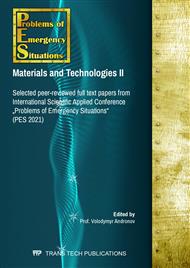[1]
Handbook of Fire Resistant Textiles, ed. by F.S. Kilinc, Woodhead Publishing Series in Textiles. (2013).
DOI: 10.1016/b978-0-85709-123-9.50027-4
Google Scholar
[2]
A.R. Horrocks, Developments in flame retardants for heat and fire resistant textiles – the role of char formation and intumescence, Polym Deg Stab. 54 (1996) 143–154.
DOI: 10.1016/s0141-3910(96)00038-9
Google Scholar
[3]
O.L. Zav'yalova, T.V. Kostenko, D.A. Zhurbinsʹkyy, Obgruntuvannya vyboru materialiv dlya vyhotovlennya spetsialʹnoho zakhysnoho odyahu ryatuvalʹnykiv vid pidvyshchenoho teplovoho vplyvu, Visti Donetsʹkoho hirnychoho instytutu. 2 (2016) 125–134.
Google Scholar
[4]
R.M. Kozłowski, M. Muzyczek 2 - Improving the flame retardancy of natural fibres, in: Handbook of Natural Fibres Processing and Applications, Woodhead Publishing Series in Textiles, 2 (2012) p.30–62.
DOI: 10.1533/9780857095510.1.30
Google Scholar
[5]
J. Alongi, A. Frache, G. Malucelli, G. Camino, Multi-component flame resistant coating techniques for textiles, in: Handbook of Fire Resistant Textiles, 2013, p.68–93.
DOI: 10.1533/9780857098931.1.68
Google Scholar
[6]
A.V. Zhurko, R.N. Khelevin, G.V. Utkin, E.V. Shatalov, S.P. Nikitayev, I.P. Shelyapin Ognestoykiy tekstil'nyy materialPatent RF 2,294,414. (2007).
Google Scholar
[7]
M.Y. Wang, A.R. Horrocks, S. Horrocks, M.E. Hall, J.S. Pearson, S. Clegg, Flame retardant textile back-coatings. Part 1: Antimony-halogen system interactions and the effect of replacement by phosphorus-containing agents, J Fire Sci. 18 (2000) 265–294.
DOI: 10.1106/16wq-nmxn-em6q-gdw9
Google Scholar
[8]
J. Alongi, C. Colleoni, G. Rosace, G. Malucelli, Phosphorus- and nitrogen-doped silica coatings for enhancing the flame retardancy of cotton: Synergisms or additive effects? Polymer Degradation and Stability. 98 (2) (2013) 579–589.
DOI: 10.1016/j.polymdegradstab.2012.11.017
Google Scholar
[9]
Akio Nodera, Toshitaka Kanai, Flame retardancy of polycarbonate–polydimethylsiloxane block copolymer/silica nanocomposites, Journal of Applied Polymer Science. 101 (6) (2006).
DOI: 10.1002/app.24191
Google Scholar
[10]
Sevim Karataş, Zuhal Hoşgör, Nilhan Kayaman-Apohan, Atilla Güngör, Preparation and characterization of phosphine oxide containing organosilica hybrid coatings by photopolymerization and sol–gel process, Progress in Organic Coatings. 65 (1) (2009), 49–55.
DOI: 10.1016/j.porgcoat.2008.09.022
Google Scholar
[11]
S.V. Levchik, E.D. Weil Developments in phosphorus flame retardants, Advances in Fire Retardant Materials. 2 (2008) 41–66.
DOI: 10.1533/9781845694701.1.41
Google Scholar
[12]
A.R. Horrocks, Flame retardant finishes, Rev Prog Colour. 16 (1986) 62–101.
Google Scholar
[13]
A.R. Horrocks Flame retardant finishes and finishing, in Textile Finishing, Society of Dyers and Colourists, Bradford, 2003 p.214–250.
Google Scholar
[14]
A.M. Emsley, G.C. Stevens The risks and benefits of flame retardants in consumer products, in Advances in Fire Retardant Materials, Woodhead Publishing, Cambridge, 2008 p.364–397.
DOI: 10.1533/9781845694701.3.363
Google Scholar
[15]
R. Dombrowski, Flame retardants for textile coatings, J. Coated Fabrics. 25(1996) 224–238.
DOI: 10.1177/152808379602500306
Google Scholar
[16]
A. Chernukha, A. Teslenko, P. Kovaliov, O. Bezuglov, Mathematical Modeling of Fire-Proof Efficiency of Coatings Based on Silicate Composition, Materials Science Forum. 1006(2020) 70–75.
DOI: 10.4028/www.scientific.net/msf.1006.70
Google Scholar
[17]
O. Skorodumova, O. Tarakhno, O. Chebotaryova, Y. Hapon, F.M. Emen, Formation of fire retardant properties in elastic silica coatings for textile materials, Materials Science Forum. 1006 (2020) 25–31.
DOI: 10.4028/www.scientific.net/msf.1006.25
Google Scholar
[18]
O.B. Skorodumova, G.D. Semchenko, Y.N. Goncharenko, V.S. Tolstoi, Crystallization of SiO2 from ethylsilicate-based gels, Glass and Ceramics (English translation of Steklo i Keramika). 58 (1-2) (2001) 31–33.
DOI: 10.1023/a:1010933028152
Google Scholar
[19]
O. Skorodumova, O. Tarakhno, O. Chebotaryova, M. Skripnik, The use of organosilicon raw materials of a technical level of purity to obtain binary protective coatings on fabric in the SiO2 sol – flame retardant system, Fire safety problems. 47 (2020) 112–119.
Google Scholar


